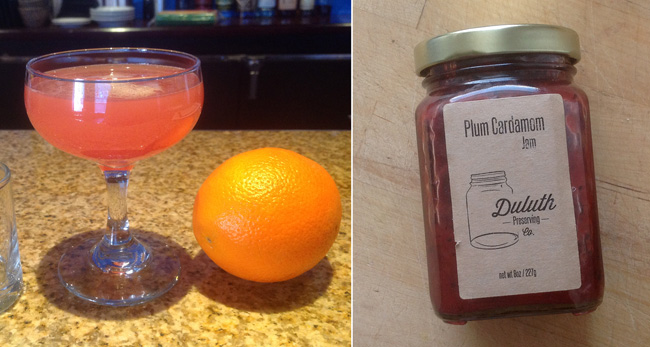Readers: What are you Toasting? What’s your favorite cocktail on the town? Or have a recipe of your own to share? Tweet your toasts to @johnpgarland and each month, our favorite submission earns you a Heavy Table pint glass.
In This Toast…We found ourselves in Duluth, the hill by the sea where the vortex is most polar. We sipped gin from a distillery that contracts with a local brewery. At that brewery’s tap room, we drank ale made with the cold press from a coffee roaster. At that coffee roaster’s shop, we found the jams from a local preserver.
We return with bison pastrami from Northern Waters Smokehaus and notes on some new drinks from up north. Mix it all together with some Valentine’s Day wine for our February Toasts.

The Paulucci building has been at the base of the aerial lift bridge in Duluth’s Canal Park since 1915. It was built by Gowan-Lenning-Brown, a wholesale grocer, before it became HQ for Jeno Paulucci. The future pizza roll inventor anchored his Chun King and Michelinas brands from the building for decades.
The room where chow mein used to roll off the canning line is now the home of Vikre Distillery. Right now, Joel and Emily Vikre are bottling and shipping their first batch of Boreal gins for locations in northern Minnesota. Expect the second and third batches to reach the metro in a few weeks.
“We both did organic chemistry, undergrad and graduate, so that was part of it,” says Emily, on becoming distillers. “Joel apprenticed at a rum distillery in Massachusetts, Turkey Shore, and we also worked out at Bainbridge Organic Distillers for a while, and that’s where we got our small spirits still [below, right] when they were upgrading.”

They’re debuting three expressions of gin right away. All three are light, clean-cut spirits and each flavor will have its partisan. There’s Juniper for the London Dry fans, a Cedar formula hoping to reacclimate the whiskey drinker to gin, and Spruce for the Hendrick’s crowd.
Also in the works is a traditional Norwegian aquavit in time for syttende mai. “I grew up drinking aquavit,” says Emily, “but I never enjoyed the taste; it’d always smack you in the face with caraway. I wanted to make one more balanced, a little sweeter, that was still caraway driven but with other flavors.”
We were able to sneak an early taste of the gins, which will retail for around $30.

Juniper: “It’s closest to a traditional gin,” Emily says. “It does sway in the floral / citrusy direction.” A steep juniper profile keeps the gin prickly but it’s matched with lots of lemon and orange peel. Rhubarb and spice support the citrus; peppercorn and currant flavors creep up on the finish.
Cedar: Sharp and woodsy. The toasted cedar gives a slightly burnished color to the spirit, and also a complementary flavor to the warm spices, cardamom and coriander. Grapefruit peel and sumac are also in play. After tasting a cedar-infused Campari, they’ve engineered this cedar gin to be ideal for a negroni. It’s warm and smoky as a sauna.
Spruce: “We wanted a nose like you’re stepping into the woods,” says Emily, “piney and resiny.” Its aroma is indeed fresh and herbal like spearmint, though no mint is used in the blend. It’s an assortment of other soft, wintery flavors like sage, fennel, rose hips, and rosemary. The spruce tips add a grassy, vegetal pine flavor to the background, supporting to the more piercing herbs. The Toast’s favorite.

A quick timeout from our Duluth trip to talk Valentine’s Day wine. The wine rules for this holiday are the same as any holiday, or Tuesday, for that matter. Drink the wines that you like. Did the two of you first lock eyes near the Charles Shaw display at Trader Joe’s? Then by all means, drink that Chuck on Friday.
If you don’t have a go-to bottle, you might be lured in by Pinot Noir. It seems about right: It’s French, sounds sexy (pee-no nu-warrr), and might come from a storybook place called Romanée or Musigny. But it’s also really expensive. And since you’re already shelling out for the flowers and the XXL steak nachos, you want to be sure your wine will be a winner, and, if possible, a good value.
Chuck Kanski advises that Rioja is what you’re looking for. The owner of Solo Vino in St. Paul (whose 6th annual legendary rosé tasting is coming up soon) tells us why these Spanish reds are a good bet for your February 14:

“People forget that Pinot Noir and Tempranillo [the most important grape in Rioja] share an ancestral connection,” says Kanski. “What you’re getting with Rioja is something you can drink before, during, and after a meal, something more balanced that will transition you from prep, to entree, to finishing that last glass when you’re done. Across the board, at every price point versus a Pinot, you’re getting a more mature vintage and more bang for your buck.”
From the multitude of Rioja available in his Cathedral Hill shop, he suggests:
Vina Real Crianza Rioja 2009, $15.99. “From the north side of the Sierra de Cantabria range, it’s affected by the oceanic weather patterns versus the Mediterranean. Cool nights means acids. You put this up against a $16 Burgundy and it’ll take it out back and work it over.”
Ostatu Crianza Rioja Alavesa 2010, $22.99. “All the classic Rioja grapes in here, 95% Tempranillo, with a splash of Garnacha, Cariñena, and Graciano. It’s from Alavesa, the Basque part of Rioja. Really good color and complexity of flavor.”
La Rioja Alta Viña Arana Rioja Reserva 2004, $31.99. “A sub-vineyard of La Rioja Alta, they only make them in the highest-quality years, four or five vintages a decade. It’s a classic, old-school Rioja, it has a sexiness, a mystery to it. You just know it’s Spanish. For the money, the best value of the three.”

Back to Duluth: The Vikres realized that they had distilling under control, but they didn’t have the same expertise in brewing. To save on startup costs they farm the initial steps out to Bent Paddle Brewing. Across town, Bent Paddle brews the fermented wash from 100% barley. Vikre takes delivery of the wash in giant tubs, which they concentrate in their stills.
Bent Paddle co-owner Bryon Tonnis (above, right) has had a busy few weeks. After pouring his lineup at Winterfest, he stayed around town to introduce Bent Paddle to his first handful of tap accounts in the metro. You can find them at both Republics, Happy Gnome, and Pizza Lucés in downtown and Seward.

The Venture Pils is a spot-on, refreshing pilsner, right up there with Schell’s, in our opinion. The Bent Hop is a robust, citrusy IPA, and the ESB is supremely balanced. If you’re lucky, you might get your hands on their Black Ale infused with cold press coffee from our good friends at the Duluth Coffee Company. And if you’re really lucky, you’ll snag some at the tap room when it’s infused with vanilla on a nitro tap.
In other beer-meets-coffee news, Indeed releases Burr Grinder this Saturday, and I go pairing Breakfast and Beer for the Growler Magazine.

Let’s Spike! Robb Jones and Duluth Preserving Co.
Since the last time we talked to Saffron barman Robb Jones (above), he’s been busy. He put together the wine and beer cocktails at World Street Kitchen, made the finals of Bombay Sapphire’s Most Imaginative Bartender competition, and garnered a Best Bartender 2013 nod from City Pages.
You’ll see the bar at Saffron packed with folks calling for a “Robb Jones Surprise.” So for this edition of Let’s Spike, we thought we’d surprise him with a jar of plum cardamom jam from Duluth Preserving Co.
“Wow, tons of cardamom smell when you first pop it,” says Jones, reaching for a spoon. He talks about using jams like simple syrups, adding them to an old fashioned for their sugar and acid. “It’s really good,” he says, tasting. “Eau de vie and cognac are coming to mind with plum. You don’t want this to get lost though; I wouldn’t use bourbon. How about a little absinthe with some gin?”

He constructs a drink from the daisy family. Dry curaçao, simple syrup, and lemon juice get shaken with the jam and a gin from Letherbee, a Chicago distillery that’s been gaining serious presence behind Twin Cities bars in the last few months. The daisy formula is endlessly repeatable with any good preserve; only adjust the citrus and sugar to taste.
2 oz Letherbee gin
1 heaping barspoon jam
0.5 oz simple syrup
0.5 oz lemon juice
0.25 oz dry orange curaçao
A few drops of Dashfire orange bitters
Shake vigorously over ice, then double strain (Hawthorne and mesh) into chilled coupe glass washed with Letherbee barrel-aged absinthe.
It’s a blushing pink cocktail that’d be perfect for Friday, though not as romantic as his others that wear hearts drawn in foam. Jones is smart to use absinthe to balance this drink. The shaken ingredients alone would taste simply like bursting ripe berries. The sugar in the curaçao and the preserves need a foil (originally the daisy would be drawn out with seltzer). The absinthe provides a bitter edge to check the sweetness and draw out a matching anise note with the gin.


Comments are closed.